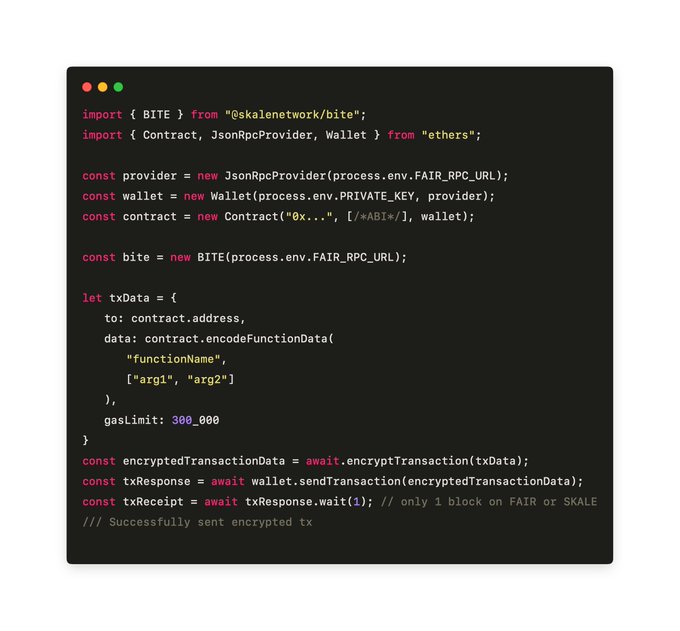**BITE** is an innovative protocol from the SKALE Network ecosystem, launching first on the new **FAIR Layer 1 blockchain**. Designed for seamless integration and massive potential, BITE enables a wide range of critical functions—ushering in a new era of encrypted, private, and MEV-resistant blockchain usage.
The following post explores the key benefits of BITE, FAIR, and the upcoming SKALE Network upgrade, including a **unique way to attain Proof of Encryption (PoE) with zero changes required from developers**.
---
## The Benefits of BITE
While some of these benefits can arrive sooner depending on SDK implementation and adoption, I’ve organized them into **short**, **mid**, and **long-term** buckets.
### 🟢 Short Term
- Fully encrypted transactions with 100% protection against MEV, including back-running
- Onchain traditional finance tools: private and FAIR TWAPs, DCA, and market orders
- Censorship resistance
- Simple integration with **zero changes to Solidity**
### 🟡 Mid Term
- AI-powered onchain trading via enhanced encrypted financial tools
- End-to-end encryption with re-encryption inside a TEE (Trusted Execution Environment), enabling data forwarding to specific parties for private decryption
### 🔵 Long Term
- Fully encrypted private state
- Onchain healthcare and banking use cases
- Fully encrypted **parallel execution** within the EVM
----
## How Proof of Encryption Works
**Proof of Encryption (PoE)** embeds encryption into the consensus layer of a blockchain. Unlike Layer 2 solutions (e.g. Unichain) that use TEEs in isolation, PoE **does not depend on decentralization alone**—it relies on **provable mathematics**.
> The SKALE Network core team has over seven years of experience building the world’s fastest leaderless BFT consensus. They’ve combined real-world application with rigorous mathematical proofs to pioneer PoE.
### 🧠 How It Works
PoE uses:
- **Threshold schemes** +
- **BLS threshold encryption** +
- **Multi-party threshold signatures** +
- **Economic PoS security**
This combo allows encrypted transaction propagation, leaderless/asynchronous consensus, and decryption via supermajority—all secured cryptographically and economically.
The result? **Private, MEV-resistant, decentralized consensus**—unlocking trillions in new financial use cases.
---
## How to use BITE
**BITE Protocol** is the implementation of PoE when used with a compatible blockchain like FAIR or (soon) SKALE Chains.
The best part? **Zero changes to your Solidity contracts**.
### Example Using BITE TypeScript/JavaScript Library

```bash
npm add @skalenetwork/bite
```
The library makes it easy to encrypt both transaction data and the `to` address in just a few lines of code.
---
### What's with the Cloud?
Over the last several years of working in blockchain, I’ve realized one thing: **an innovative product is only useful if it’s easy to implement**. That’s why I collaborated with [@0xRetroDev](https://x.com/0xRetroDev) to build a simpler, cloud-based design for broader adoption.
### Background
If you’ve heard of **Flashbots**, **CoW Swap**, or **Jito**, you know they’re tied to **MEV** (Maximal Extractable Value). If not, here’s a simplified breakdown:
- **MEV** is profit gained by reordering or inserting transactions.
- **Bad MEV** = front-running, sandwich attacks, back-running.
- **Good MEV** = arbitrage, liquidations that help price stability or protocol solvency.
- **Some firms (e.g. Jito)** make validators more profitable via MEV.
- **Others (e.g. CoW Swap)** attempt to *protect users* from MEV.
> **Bottom line:** MEV is mostly harmful and extracts value away from users.
### Simplifying Adoption
Widespread usage builds a **network effect**. Just as Jito dominates Solana validators and MEV-blocker RPCs like CoW Swap are spreading, we aim for BITE to be universally accessible—across stacks, devices, and languages.
### Phase I: BITE API
A PoC implementation is already live thanks to [@0xRetroDev](https://github.com/0xRetroDev):
🔗 [BITE API GitHub Repo](https://github.com/0xRetroDev/bite-api)
This API allows any transaction to be encrypted by calling the endpoint. It’s ideal for:
- Environments without native BITE SDKs
- Languages outside JavaScript/TypeScript
- Setting up early MPC experiments or agentic flows
> ⚠️ **Note:** Because `eth_estimateGas` can't work properly with encrypted transactions, this can unintentionally leak user intent if used via 3rd-party RPCs.
A production-ready version will soon be hosted via [Eidolon.gg](https://eidolon.gg) for the FAIR + SKALE Communities.
---
### Phase II: Private BITE API
To fully solve the **privacy problem**, we propose a unique infrastructure setup modeled on how FAIR and SKALE operate.
#### Infrastructure
1. Run a TEE (Trusted Execution Environment)
2. Generate a private key *inside* the TEE
3. Expose the **public** key via API
#### SDK Flow
4. Client requests public key
5. Client encrypts transaction payload using public key
6. TEE decrypts using internal private key
7. TEE re-encrypts using FAIR/SKALE BLS committee key
8. Returns encrypted payload to client
9. Client signs + broadcasts
This allows **any client**—C++, Kotlin, IoT, etc.—to securely use BITE without needing full Web3 tooling or native SDK support.
Yes, there are risks and trade-offs here. But I believe this is a great **early-stage design** for broader PoE adoption.
---
## 👋 About Me
Hi, I’m **Sawyer**, a software engineer, developer relations lead, and operational consultant with a background in healthcare and blockchain.
- Follow me on [X](https://x.com/thegreataxios)
- Connect on [GitHub](https://github.com/TheGreatAxios)
- You can [Buy Me a Coffee](https://buymeacoffee.com/thegreataxios)
- Need help? Contract [Dirt Road Dev](https://dirtroad.dev)
Feel free to DM me with questions or collaboration ideas. Thanks for reading!
— **TheGreatAxios**